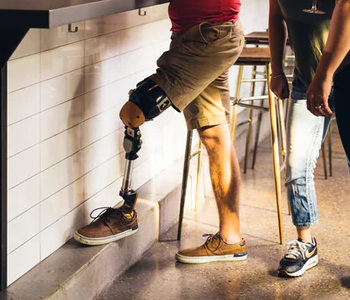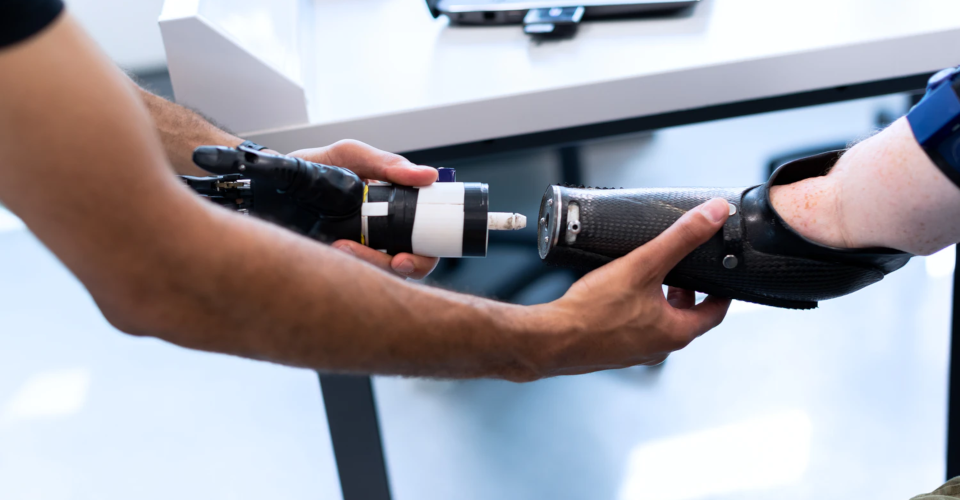3D Printed Prosthetics: The Next Revolution
According to the World Health Organization (WHO), more than 40 million are amputees in developing countries. However, only 20% of them can afford prosthetics. The amount of time it requires to manufacture and customize prosthetics is what makes them so expensive. Thankfully, 3D printing technology makes low-cost 3D printed hands and legs available to more people.
Many possibilities surround 3D printed prosthetics. First, they help incapacitated people with congenital conditions. Second, they can replace fingers, limbs, and even part of a face. Soon, they will present endless opportunities for everybody to bring a part of their body or self-confidence back.
What Are 3D Printed Prosthetics

3D prostheses are functional prostheses of various body parts. They are developed through 3D printing technology, making them affordable to everyone and extending their manufacture to a common user. There are even 3D printed prosthetics for the youngest. In a word, they are changing the face of medicine and engineering.
3D printed prosthetics use affordable manufacturing techniques, which make them an incredible alternative to traditional prosthetics. They are also made with various materials and are easy to customize. Materials often used in 3D printing include ABS plastics or the stronger Bridge nylon. Other printers are compatible with titanium, which boasts increased durability and strength.
Most Common 3D Printed Prosthetics
3D printing prosthetics are changing lives for the better. They are accessible to everyone who needs them. Some of the most successful and most common printed prostheses these various parts of the body:
Hand
3D printed prosthetic hands are for people who lost their limbs starting at the wrist. They focus on developing movable fingers and, more importantly, allowing grip. The most common material used for prosthetic hands is plastic because they are lightweight, functional, and durable.
The most sought-after prosthetic hand is Youbionic. Created by Italian engineer Federico Ciccarese, it combines three technologies: myoelectric technology, 3D printing technologies, and the famous Andrino open-source plate. Through sensors, you can feel the muscle that allows the user to make different grip movements.
Forearm
3D printed prosthetic forearms are for people who lost their arms. You can match a prosthetic hand to them, specifically compatible with the model. Thanks to 3D printing, they can be fun for kids who need them. They are available in various colors and highly customizable.
The Hero Arm is the world’s first clinically-approved bionic arm. It has multi-grip functionality, empowering aesthetics, and myoelectric functionality. It is also available in different designs, inspired by Frozen, Iron Man, and Star Wars. More impressively, it has various other functionalities, including grab, pinch, high-five, and thumbs-up.
Leg

Leg prostheses are the most complex of all because they have to carry more weight. They mimic the function and, sometimes, the appearance of a real leg, helping users regain their mobility and freedom of movement.
Through 3D printing, companies have begun to develop models of legs that are fully customizable by users. You can choose the color, material, and total adaptation to your anatomy. The most famous example is the one worn by Paralympic Games silver medalist Denise Schindler.
Feet
Foot prostheses allow the wearer to walk. But, some people use them for cosmetic reasons. Traditionally, they come in two types: Solid Ankle Cushioned Heel (SACH) or Elastic Keel configurations. The challenge for 3D printed prostheses is achieving the same level of mobility and comfort as classic materials.
Mércuris, a specialist in foot prosthetics, uses 3D printing to create its models. Mércuris is marked with the highest quality certification of the European Union, allowing you to develop your personalized prosthesis through the company’s online platform and pick it up in just a week. They also build foot prostheses for children.
Finger
Prosthetic fingers are for people who lost one or more fingers but still have their palms. Similar to arms, they are often made of silicone for aesthetic reasons. Whether you are shaking hands or giving a presentation, you will surely feel confident and comfortable with silicone finger prostheses.
When it comes to finger prosthetics, Naked Prosthetics is the best. The company specializes in it through 3D printing. Its founder, Colin Macduff, used his experience in the army to design a functional finger for himself. Now, their finger prostheses allow those who have had amputations to play ping pong or finger-pick a guitar.
Dental Prosthetics
Dental prostheses are dental appliances that replace one missing tooth, a few in a row, several teeth throughout the mouth, or all teeth. The most common types include bridges, crowns, and dentures. Some can be removable, while others are permanently fixed in the mouth. All, however, prevents bone loss, restores bite force, prevents changes in the face, and enables natural speech.
3D technology helps dental patients save time and money. Biotech Dental offers high-quality dental prosthetics with flawless traceability. They use the latest advancements to address the needs of patients adequately.
Costs of 3D Printed Prosthetics

According to the American Orthotics and Prosthetics Association, the average prosthetic costs between $1500 to $50,000. It depends on the part of the body being replaced. For instance, a prosthetic leg can range between $5,000 to $50,000. However, this is not a one-time cost. Even the most expensive prostheses can only last for three to five years. Plus, this expense is often paid out of your pocket as insurance does not cover it.
With prosthetics lasting only five years, the cost is important. In contrast with traditional prosthetics, 3D printed prosthetics help people move again without breaking their banks. They cost as little as $50. 3D printers use a computer-aided design (CAD) program to apply layers of materials and create a highly precise finished part in as little as a day.
Tons of Low-Cost Options
Every year, millions of people need new prosthetics or replacements for their current devices. There are hosts of low-cost options, including polycentric titanium prostheses and single-axis versions. They cost a fraction of a cost but do not offer the advanced functionality that the more expensive microprocessor prosthetics offer. Another possible low-cost alternative involves donated prostheses from high-income nations. However, not all are appropriate for the environmental conditions of less-resourced countries.
D-Rev and a handful of companies in Canada and the US are working on a bold goal to help people with amputations. They are currently developing more affordable, adjustable, and high-quality prosthetics for amputees in less-resourced nations while keeping their companies profitable. As a result, they enable them to be efficiently mobile and to live productive, healthy lives.
Benefits of 3D Printed Prosthetics
The technology of prosthetics has been steadily improving over the years. It has evolved from wooden toes in Ancient Egypt and iron hands in the 16th century to the contemporary custom-fit prostheses with microprocessors and hydraulic and pneumatic controls to promote natural movement. To top it all off, the arrival of 3D printing helped change the lives of ordinary people who cannot afford conventional high-tech prosthetics.
Reduced costs
For kids and teens who have lost their limbs, a conventional prosthetic can be a huge financial burden for their parents. They grow up so fast that they need to change their device every few years, if not months. Add this to the fact that kids are active and have a tendency to break things. Imagine how much it will affect low-income families who barely struggle to feed themselves.
Of course, the financial burden is no less for adult amputees. 3D printed prosthetics help amputees in need. 3D printers can produce prostheses for as low as $50, restoring a degree of movement and control that otherwise is lost forever.
Access to more people
The cost reduction greatly increases the accessibility of prostheses to more people. Lower 3D printer prices allow more people to buy their own or access them more easily. This enables them to download free files from various organizations and use them to make their prosthetic body parts. ECF, for instance, offered its services to Haitians who lost their limbs to the 2010 earthquake.
Improved physical independence

Losing a limb always results in mobility problems. Hand amputees have trouble picking up objects, while leg amputees have difficulty maintaining balance and getting around. Nothing can replace limbs, but prosthetics are the next best thing. They make it easier for people to regain balance and do basic tasks, paving the way to physical independence.
3D technology allows amputees to enjoy greater independence. Many 3D hands, for instance, enables them to grasp things, such as cups, toys, and other small objects. 3D printed legs, on the other hand, help with balance and movement. As a result, mobility and physical independence are no longer limited to those who can afford traditional prosthetics.
Help heal emotional pain
Losing a limb is not easy. You have to deal with the fact that you can no longer be active. Children may suffer from teasing and bullying. Adults need to find ways to stay productive and efficient. 3D printed prosthetics help maintain your self-esteem, making life a bit better. They make you more confident in yourself and your abilities. In return, you can imagine a better future and become motivated to achieve your goals.
How Long Do They Last?
3D printers have reduced production time drastically, making 3D prosthetics more affordable and accessible to ordinary people. They are also user-friendly and require bare minimum skills to operate. However, they only last for about five years. Fortunately, they only cost about $50. The reduced cost greatly benefits children. They grow so rapidly that they need new prosthetics more frequently.
Materials Used in 3D Printed Prosthetics
Like traditional prosthetics, 3D-printed prostheses are primarily composed of plastic. You can make them from almost all 3D printing thermoplastic, but Polylactic Acid (PLA) and Acrylonitrile Butadiene Styrene (ABS) are the most common. You can also use the stronger material, Bridge Nylon. Moreover, 3D printers are becoming compatible with lightweight materials like titanium for increased durability and strength.
Other exotic materials used in 3D printed prosthetics include carbon fiber reinforced filaments, flexible filaments, and conductive filaments.
- Carbon fiber reinforced filaments contain short strands of carbon that make them stiffer than most filaments. They are a great material choice for weight and rigidity optimization, such as prosthetic legs’ sockets.
- Flexible filaments, like thermoplastic polyurethane (TPU), are soft and flexible. They are perfect for creating joints, as you see in prosthetic fingers.TPU is also used in bionic hands.
- Conductive filaments use ETPU, which combines carbon powder and TPU to develop a flexible and electrically conductive polymer. They use graphene powder instead of short carbon fibers to conduct electricity but do not add mechanical strength. They prove to be effective on touch sensors in bionic fingertips.
Wrap Up: Helping People Move Again
Without a prosthetic limb, people struggle to prepare food, perform favorite activities, and above all, work. This throws them back to their families and slashes their self-confidence. However, prosthetics are very expensive and can take a long time to customize. 3D printing technology makes 3D printed prosthetics available to more people, helping them move again.
3D printed prosthetics also make people feel complete again. They do not just bring their body parts back but a part of their selves, too. More impressively, they do not only help amputees but disabled people with congenital conditions that require prosthetics as well. There are so many possibilities surrounding 3D printing technology. Endless opportunities will soon be available to more people around the world.





